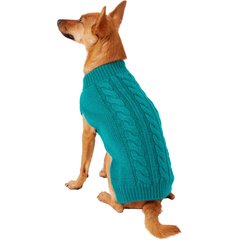How Cold Is Too Cold for Dogs?

Photo by arlutz73/iStock/Getty Images Plus
Yes, your dog has a fur coat—but when winter temperatures dip, it may not be enough to keep them warm outdoors. Find out how cold is too cold for dogs, how to tell when your dog is cold, and what you can do to help keep them warm.
Key Takeaways
- Even the most cold-tolerant dogs can quickly develop hypothermia and frostbite when temperatures fall below 20 degrees Fahrenheit.
- More vulnerable dogs can be at risk starting at 32 degrees Fahrenheit and may feel uncomfortable when temperatures drop below 45 degrees Fahrenheit.
- Environmental conditions and individual characteristics influence how a dog handles cold weather.
- Whining, slowing down, shivering, anxiety, lifting paws, and cold extremities all indicate that a dog is getting too cold.
Do Dogs Get Cold?
Despite the cold temperatures and piles of snow (or maybe because of them!), many dogs are enthusiastic about outside adventures in the winter. This can mislead pet parents into believing that dogs don’t get cold, or at least that they are much less vulnerable to the cold than people are.
But cold weather can create significant health problems for dogs, including frostbite and hypothermia.
How Cold Is Too Cold for Dogs?
There is no one-size-fits-all answer to the question of what temperature is too cold for dogs. Just as you might feel perfectly comfortable in 50-degree weather when the sun is out but feel unpleasantly cold at the same temperature when it’s windy and raining, many variables affect how your dog experiences different temperatures.
Environmental Variables
- Wind chill: Wind increases the rate at which heat is lost from your dog’s body as it penetrates their coat.
- Moisture: Wet or damp fur doesn’t insulate as well as dry fur, and evaporation removes heat from the body. Any kind of moisture can make your dog feel colder.
- Cloud cover: A clear, cloudless day will help your dog stay warmer in cold weather because the heat from the sun warms your dog.
Individual Variables
- Size: Small dogs proportionally lose more heat through their skin than big dogs.
- Weight: Body fat helps insulate dogs from winter weather. A heavier dog will therefore be able to stay warmer than a skinnier dog.
- Coat type: Dogs who have an extremely dense undercoat in addition to an outer coat (Alaskan Malamutes and Pomeranians, for example) enjoy the most protection from the cold. Single-coated dogs, such as the Whippet, only have an outer coat and get cold easily. It is important to remember that long hair doesn’t necessarily keep dogs warm.
- Age and health: Dogs who are very young, very old, or sick require greater protection from the cold, because they cannot regulate their body temperatures as well as dogs in their prime.
- Physical exertion: Movement generates body heat, so if your dog is highly active, they will stay warmer in lower temperatures.
- Acclimation: Dogs who live in colder climates and routinely spend time outside can deal with the cold better than dogs from warmer climates.
Veterinarians can still give general advice to dog owners as to when low temperatures become dangerous.
- At 45 degrees Fahrenheit: Dogs who are especially vulnerable to the cold (small, thin-coated, young, old, or sick dogs, for example) can feel uncomfortably chilled.
- At 32 degrees Fahrenheit: Most dogs begin to be at risk for cold-related health problems, such as hypothermia and frostbite.
- At 20 degrees Fahrenheit: Even the most cold-tolerant dogs should be closely monitored when outside.
How Do I Know if My Dog Is Cold?
Many signs that a dog is getting too cold are easy to recognize because they are similar to what people experience when they get cold. When in doubt, it’s always best to head inside and warm up.
- Behavioral indicators: If you observe changes in your dog’s behavior, such as whining, slowing down, seeking warm spots, acting anxious, or holding up paws, they are likely getting cold.
- Physical indicators: Shivering is a fairly reliable sign your dog is too cold, but it actually can disappear as hypothermia worsens. Pale skin and extremities that are cold to the touch can be a sign of frostbite, so don’t wait until these have appeared to warm up your dog.
If you need to warm your dog quickly, bring them inside a heated building or car and, if possible, wrap them with blankets or towels that have been heated using a clothes dryer or radiator. Hot packs or bottles filled with hot water (separated from your dog’s skin by a couple of layers of fabric) can speed up the rewarming process.
If you think your dog could have hypothermia or frostbite, bring them to a veterinarian immediately.
How To Keep Your Dog Warm in Winter
The easiest way to ensure that your dog stays warm during winter is to limit their time outdoors. But when nature (or adventure) calls, there are several ways to keep your dog out of harm’s way.
- Dog boots will protect your dog’s feet from the cold, sharp ice, the chemicals in ice melt, as well as those annoying balls of snow that collect between and around paw pads.
Recommended Product
A warm dog sweater is good for chilly days, but a wind– and water-resistant dog coat provides the most protection from extreme weather.
Recommended Products
Dogs are happiest and safest when they’re inside with their people, but a heated and insulated dog house can provide temporary shelter outdoors.
Recommended Product
How Cold Is Too Cold To Walk a Dog?
While activities such as walking generate some body heat, there comes a point where it is simply too cold to spend much time outside. When temperatures fall below freezing, start paying close attention to your dog’s behavior and cut walks short if they start acting like they’re cold.
Once temperatures reach 20 degrees Fahrenheit, hypothermia and frostbite can occur quickly, so it’s best to limit walks to 10 minutes or less—just enough time to take care of business. Schedule more indoor exercise and play to prevent boredom.
FAQs About How Cold Is Too Cold for Dogs
How do I know if my dog has hypothermia?
Some of the first signs that a dog is becoming hypothermic are shivering; cool body surfaces; confusion; sluggishness; and stiff, uncoordinated movements. Once hypothermia progresses to a critical stage, shivering will stop. When in doubt, see a veterinarian immediately.
What dog can withstand the coldest temperature?
Dogs’ ability to withstand cold temperatures varies, but some of the best dog breeds for cold weather include Siberian Huskies, Alaskan Malamutes, Saint Bernards, American Eskimo Dogs, and Great Pyrenees.









